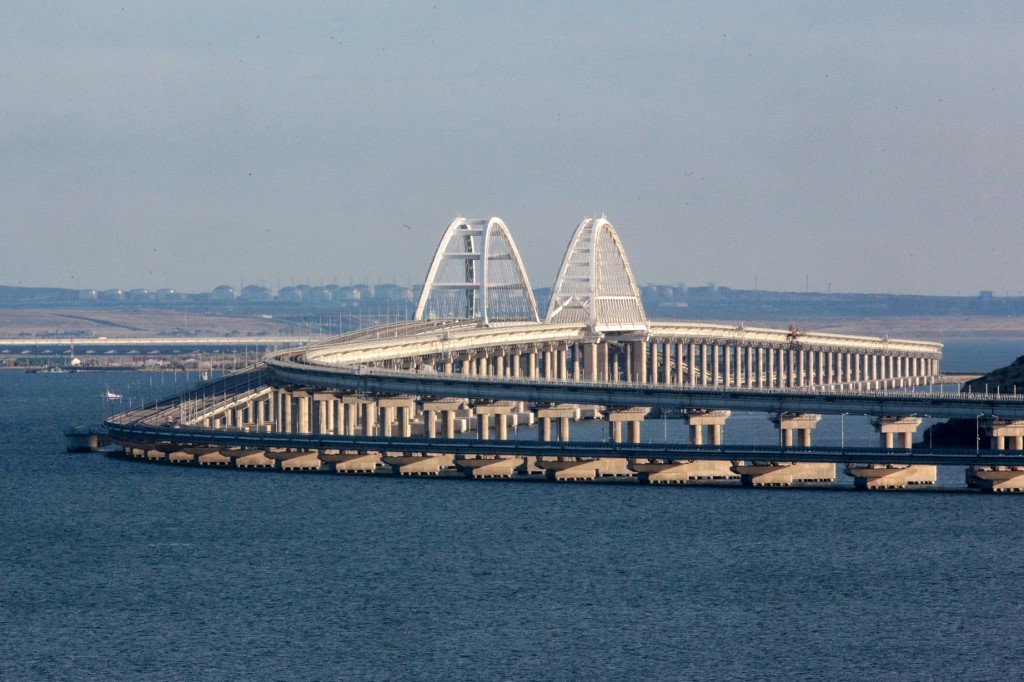Ukrainian precision-guided missiles sank an armed minesweeper tied up at a military wharf in Sevastopol and likely also blew up one of the Russian navy’s most modern guided missile boats, a Ukrainian Naval Forces spokesperson said on Monday.
Navy officer Dmitro Pelenchuk in comments aired by Radio Liberty on Monday said that Kyiv’s military intelligence has confirmed that the Russian minesweeper Kovrovets was sunk at her moorings in the Crimean port in an attack taking place in the early morning hours of May 19.
JOIN US ON TELEGRAM
Follow our coverage of the war on the @Kyivpost_official.
The Kovrovets is a Project 266M (NATO designation Yurka-class) minesweeper with a displacement of 873 tons. The Soviet Union built dozens of that ship class during the Cold War. At the start of the Russo-Ukraine War, two of the minesweepers were listed as elements of Russia’s Black Sea Fleet. At full strength the crew numbers 68 men and officers. Its primary mission in combat operations against Ukraine has been sweeping seas around Sevastopol naval base for anti-ship mines.

Ukrainian naval spokespersons on Sunday evening, only hours after the attack, claimed the ship was destroyed. There were no early reports of casualties, if any, aboard.

Sanctions Busting: Germany’s Role in Dodging Russian Sanctions
The Tsyklon (Cyclone) is a Project 22800 (Russian navy designation Karakurt) guided missile corvette with a displacement of 800 tons. The ship was one of Moscow’s newest, delivered to the Black Sea Fleet in August 2023. The max crew is reportedly 70 men and officers. The vessel’s main armament is the Kaliber cruise missile, a weapon used since October 2022 by Moscow to bombard Ukrainian homes and businesses. For reasons known to Black Sea Fleet command, the Tsyklon never launched any missiles at Ukraine and for its entire combat career served as an air defense platform based in Sevastopol, Pletenchuk said.

The independent Astra news platform reported the wharf where the Tsyklon was moored was hit by three ATACMS missiles that killed six service personnel and injured eleven. Local air defenses shot down nine missiles out of the twelve-weapon attack, a Monday report said.
Russian news platforms and milbloggers widely confirmed the loss of both ships, and most reported one or more US-manufactured long-range ATACMS surface-to-surface missiles, a weapon Kyiv had implored Washington to send for almost two years, were the weapons the Ukrainians used in the strikes.
White House officials in April announced they had reversed a ban in place for more than two years on export of long-range missiles to Ukraine and acknowledged that transfers of modern versions of the ATACMS MGM-140 surface-to-surface missile to Kyiv would go forward.

The Biden administration did not make public the specific model of ATACMS to be provided. Confirmed Ukrainian strikes in late April in May offered evidence the munition was most likely sent by Washington to Kyiv was the M39A1 Block I missile armed with a cluster munitions warhead. kyiv in past weeks has used the weapon effectively as Americans designed, attacking soft targets vulnerable to cluster munitions – particularly aircraft and air base infrastructure.
Cluster munitions are too small to sink or even substantially damage a military minesweeper. Some milbloggers both in Russia and Ukraine on Monday were arguing damage caused by the Sunday strikes in Sevastopol meant that the US had also sent Ukraine more modern M48 or M57 ATACMS missiles, which are armed with a single warhead loaded with 214 kilograms of high explosives. A direct hit by a warhead that size would almost certainly damage an 800-ton military vessel if the explosion were close, and a direct hit probably would destroy it.
However, according to open sources, the latest versions of the US-made ATACMS are on average able to hit within 5-9 meters of an aiming point, making the weapon a possible but not ideal munition for attacking a warship measuring some 65-75 meters in length, and 9-10 meters wide at the beam.

Kyiv in past attacks against Russian navy fleet elements has used its own domestically manufactured Neptune missiles and French/SCALP, British/Stormshadow anti-ship missiles, at times to devastating effect.
Ukrainian Neptune missiles sank the Russian Black Sea Fleet’s biggest and most powerful, the flagship cruiser Moskva, in an April 2022 attack. The single worst defeat suffered by Russia’s Black Sea Fleet during the Kremlin’s full-scale invasion of Ukraine took place on Sep. 13-22 2023, when SCALP/Stormshadow missiles penetrated Sevastopol’s dense air defenses to destroy an assault ship, a missile attack submarine and smash Black Sea Fleet headquarters, reportedly killing the fleet’s vice commander.
Russian naval commanders pulled most major warships out of Sevastopol in October, effectively abandoning Moscow’s main Black Sea naval base for the first time since 1941. By warship tonnage, since Russian invaded Ukraine a bit more than half of the Black Sea Fleet has been destroyed in action.
Aside from light patrol vessels Ukraine has no naval ships or submarines, and has fought a sea war against Russia using air and sea drones, anti-ship missiles, and surface-to-surface ballistic missiles.
You can also highlight the text and press Ctrl + Enter






